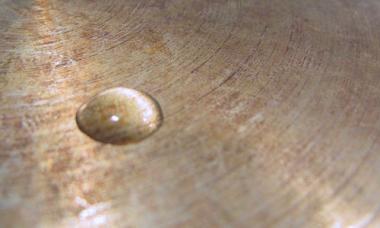Perhaps you are one of those gifted culinary artistes who communes with the stove—one who can orchestrate the chopping, the ringing of the pan with oil, all that poaching and braising, and do it with elegance. The rest of us have to pursue that goal with a more dogged approach. The rest of us make a lot of pancakes that look like ungainly asteroids before we produce a crepe that would make Jacques Pepin raise an eyebrow in appreciation.
As a longtime trial-and-error cook, I regarded the recent acquisition of a stainless steel skillet as a challenge. Could I cook with such a top-shelf tool without spending an hour after dinner with steel wool in hand to remove welded-on pasta?
Well, no, actually. I couldn't.
First time out, I placed upon the heated, oiled pan a nice piece of breaded cod. A few minutes later, I flipped the cod, leaving every bit of breading bonded irretrievably to the skillet.
Yet check out any proper chef on the television, and they happily sautee till the cows come home with their stainless steel, leaving its mirror finish unspotted by the merest troublesome speck. Clearly, these folks did in fact learn something at those bigshot culinary institutes. But what could it be? I mean, there are only a couple of variables here—the heat of the pan and the heat of the oil. Sure, some things stick worse than others, but those impossible TV chefs always seem like they could sautee actual glue and it wouldn't stick. I tried getting the pan hotter, heating the oil longer. The bonding of substances I achieved could never be duplicated by mere adhesive.
I considered donating the pan to the Salvation Army and cursing the kitchen gods. Then, as fortune would have it, I stumbled upon the very piece of knowledge I needed, right on the World Wide Web at the very fine blog called Later On, which featured a rouxbe.com instructional video. There really is a trick to stainless steel, and it really works. It is the closest thing I have seen to culinary magic, and learning it was a true game-changer. Here's how.
Get a glass of water and a small spoon. Turn the heat on your stainless steel up to somewhere in the medium-high range (you'll figure it out more exactly later). Wait a while, unless you're blessed with a gas stove. Then get a small amount (the online version says 1/8 teaspoon) of water in the spoon and drop it into the pan. As the pan heats up, the water will bubble, then evaporate. Try this again maybe 15 or 30 seconds later. The water will eventually evaporate almost instantly.
This point, for many folks, seems like just the right temperature at which to start cooking, aka "pretty hot." But soldier on. Let the sucker keep heating. Soon you'll drop the water and it will sizzle furiously, but not evaporate as fast (really). A central blob of water will throw out tiny blobs in all directions, and all the water will eventually disappear. Keep heating. A little after that point is reached, something truly curious occurs: the water stays in a single blob, looking much like mercury, and it floats around on the pan like an air hockey puck. It will take quite a while to evaporate. This may defy logic, but it happens nonetheless. That's when you're ready to cook, but a further word is in order before proceeding—if you go past this perfect point (and you can, very quickly), the blob of water will disintegrate in all directions and sizzle away. If that happens, you have to cool the pan down.
If you've got that perfect blob skating around, grab your oil and pour it in. (You can first pick up the pan and tilt the water into its rim, where it will evaporate.) The oil will shimmer beautifully. It will take a very short time to heat up at this temperature, so don't delay too much. Get your food in the pan and go. If you've done this right, what follows will be just what those TV chefs get: fast cooking, perfect browning, and absolutely nothing sticking to the pan. If you get a straggler that insists on sticking anyway, just deglaze when you're done and it will easily lift off. Your guests will swoon and your neighbors applaud.
It's worth noting that this only applies to stainless steel. Other substances don't seem to be so exacting. The reason this works is the Leidenfrost Effect, a nifty high-temperature phenomenon that enables stunts like sticking one's wet hand into molten lead without harm (that I have no plans to try, thanks). The reasons for this effect are perhaps beyond the scope of a food column, but you can read about it at the Houseboat Eats link below, where you'll also find the video from www.rouxbe.com. Happy non-sticking.
Later On: leisureguy.wordpress.com
Houseboat Eats: www.houseboateats.com/2009/12/on-properly-heating-your-pan.html



